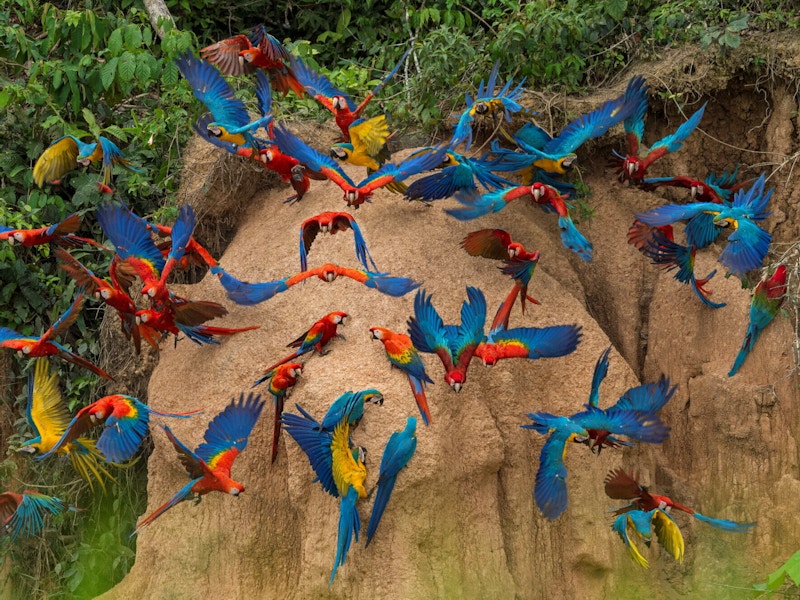
COP15: Negotiations on the Global Biodiversity Framework
Rainforest protection is key to successful nature agreement
Never in modern history have the conditions been better for world leaders to reach a strong global agreement for humans to live in harmony with nature and prevent mass extinction, says Rainforest Foundation Norway.
CLAY: Ara parrots (Ara macao and ara ararauna) eating clay in the Peruvian Amazon. Photo: Thomas Marent
5 December 2022 Montreal/Oslo
Human activity has caused the mass extinction of species and the destruction of entire ecosystems. Now, the world is at a pivotal point. As leaders gather in Montreal this week, conditions are ripe for reaching a strong agreement for protecting what is left of global nature.
Protecting large, contiguous areas of untouched rainforest is vital to a successful agreement. The world’s tropical rainforests are home to more than half of the world’s biodiversity, and it will be impossible to solve the nature and climate crisis without protecting the life inside these forests.
“In our more than 30 years of working to protect the rainforest, we have never seen such momentum for rainforest protection. Governments, businesses, and people are mobilizing, and we all know we have a tough challenge ahead of us. The new agreement can set the path for how we can collaborate across nations and sectors of society to live in harmony with nature,” says Toerris Jaeger, Executive Director at Rainforest Foundation Norway.

Patrol: Members of the Yanomami people in the Brazilian Amazon regularily patrol their rainforest on the lookout for illegal gold mining. Photo: Thomas Nilsen/VG
Right now, there is cause for optimism; There is recent political will in rainforest countries such as Brazil and Colombia to preserve their forests, there is a demonstrated willingness in Europe and the USA to channel more funds than ever before, and EU laws regulating the import of agricultural products driving deforestation are being passed.
In addition to governments, investors, businesses, and consumers are also getting serious about rainforest protection.
“We need business and investors fully on board, and it gives us hope when we see them increasingly wanting to eliminate deforestation from their supply chains. Although progress is too slow, there is momentum. And for those who chose to ignore this issue, better satellites and surveillance opportunities make it harder to hide illegal and activities,” Jaeger continues.
Rainforest Foundation Norway supports the so-called 30 by 30
initiative of protecting 30 percent of the world’s nature by 2030, an
ambitious increase from the current 17 percent.
“Protecting 30 percent of planet Earth would not only send a strong signal to governments and businesses to increase the protection of nature, it would also be an effective measure. However, the target needs to prioritize valuable ecosystems like intact rainforests, it must prohibit environmentally damaging activities within these areas, and the rights of indigenous peoples and local communities must be secured when implementing the target,” Jaeger says.

POISON: A Harlequin poison frog in the Colombian rainforest. Photo: Thomas Marent
Rainforest quality and connectivity
Some key criteria are
necessary for ensuring a strong and effective agreement. Much of
international forest policy is focused on securing the amount of
rainforest in square kilometers. Although it is important to preserve
all rainforests, Jaeger expects the new nature agreement to have
specific targets to secure the quality of these forests.
“The abundance
of life in a million-year-old rainforest cannot easily be recreated. Only a third of the original tropical rainforests are intact. The
agreement must ensure that what is left is not lost,” Jaeger
says.
Large, contiguous rainforests are also vital; Large mammals need vast areas to roam, and the fragmentation of tropical rainforests by roads, mining, and agriculture, has pushed large animals, such as orangutans and Sumatran tigers, to the brink of extinction.
Forest peoples' rights
Science increasingly agrees that the level of biodiversity found in rainforest areas managed by Indigenous peoples has denser biodiversity than other areas, yet Indigenous peoples are frequently prosecuted and excluded from decisions concerning their land.
“Indigenous peoples have never lost the understanding of the intrinsic value of the forest itself and have for centuries found ways of living in harmony with nature. It is not only morally right, but also a necessity for the effectiveness of the nature agreement that it ensures the protection of Indigenous peoples’ rights to their land and their right to be included in decisions concerning them,” says Toerris Jaeger, Executive Director of Rainforest Foundation Norway..

Anders Haug Larsen
Advocacy Director
(+47) 932 17 626
andershl@rainforest.no